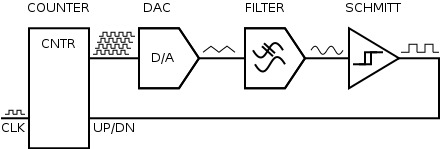
Breadboard One | Mixed Signal Circuit | Block Diagram

Breadboard One | Mixed Signal Circuit | Block Diagram
We designed Breadboard One as the first BitScope Ed project because it's a simple mixed signal circuit which explains the key elements of modern mixed signal systems.
A Mixed Signal Circuit is one which has both analog and digital components. In analog circuits the currents and voltages vary continously whereas in a digital circuits they switch between discrete values (high and low) to represent logical or numerical values.
Almost all modern electronic systems comprise mixed signal circuitry but the development methods and diagnostic tools you need to design and debug the analog and digital components of these circuits are quite different.
The block diagram above shows Breadboard One which comprises four primary circuit components:
| Component | Type | Description |
| COUNTER | Digital | 4 bit UP/DOWN Counter (CD4029) |
| DAC | Mixed | 4 bit R/2R Digital to Analog Convertor |
| FILTER | Analog | Passive RC Low-Pass Filter |
| SCHMITT | Mixed | Inverting Schmitt Trigger |
Breadboard One | Circuit Components
We will explain the design, operation and diagnosis of each of these components in forthcoming posts but for now, take note of each component's type.
The COUNTER is exclusively a digital component. It accepts a digital clock (CLK) input and produces a 4 bit binary output on 4 separate digital signals.
By contrast the FILTER is an analog component. It accepts an analog signal at its input and produces another (filtered) analog signal at its output.
The other two components are mixed signal devices. The DAC accepts the 4 bit binary encoded digital signals from the COUNTER and produces an analog sawtooth output. The SCHMITT trigger comparator accepts the analog output of the FILTER and produces a digital output signal which feeds back into the COUNTER Up/Down input.
To analyze and debug these components as well as the circuit as a whole requires a range of test equipment.
For analog signals an oscilloscope and sometimes a spectrum analyzer are invaluable tools. They show continuous changes in voltage and current over time or the frequency characteristics of signals in a circuit.
For digital signals these instruments can be useful but more often you will be need a logic analyzer which can show the the relative timing of the high and low transitions of multiple digital signals at once or decode a sequence of transitions to show serial data.
Of course one usually needs a power supply and in many cases a waveform generator or clock generator. More specialized tools like a frequency meter can be useful and a simple voltmeter or current meter are often handy.
All these test instruments and many of the associated tools are what BitScope provides, all in single compact device with connections made via its Smart Port Interface. Breadboard One connects directly but logic probes or analog probes like DP01 can be used too. Some BitScopes have BNC inputs for use with standard oscilloscope probes.
For a bit of fun, we built an Electronic Projects Lab for Raspberry Pi based on Breadboard One to test the circuit (as shown in this screenshot taken from a monitor connected to a Raspberry Pi).
Why is the waveform produced by the circuit at the output of the FILTER (yellow trace) a triangle?
To answer this question we need to understand the operation of the entire circuit, its digital, analog and mixed signal components. We'll explain each of the components individually in future posts.
For now, consider how they work together.
BitScope's waveform generator is connected to the COUNTER clock (CLK) input. It provides the clock that drives the entire circuit. The counter counts UP producing a linearly stepped increasing number.
This number, encoded as a set of 4 binary signals, drives the DAC which produces an increasing voltage for each new value it receives. This analog output signal from the DAC is passed through low pass FILTER to smooth it before appear at the (inverting) SCHMITT trigger input.
The SCHMITT output (a digital signal) switches from HIGH to LOW when the voltage passes a high threshold (a voltage of about 2/3 of the power rail) which flips the COUNTER to count DOWN instead of up. This reverses the DAC voltage producing a downward ramp until the SCHMITT switches again (at about 1/3 of the power rail voltage) and the process repeats so long as the clock continues to run.
This produces the triangle shaped waveform seen at the FILTER output.
This previous description outlines the fundamental operation of the Breadboard One mixed signal circuit. In theory its operation is reasonably straightforward but in practice the real world can get in the way. It's a triangle waveform but it's a little distorted. Why? There seems to be some noise on some of these signals. Where does it come from?
We hope to address questions and many others down the track in BitScope Ed, so stay tuned!